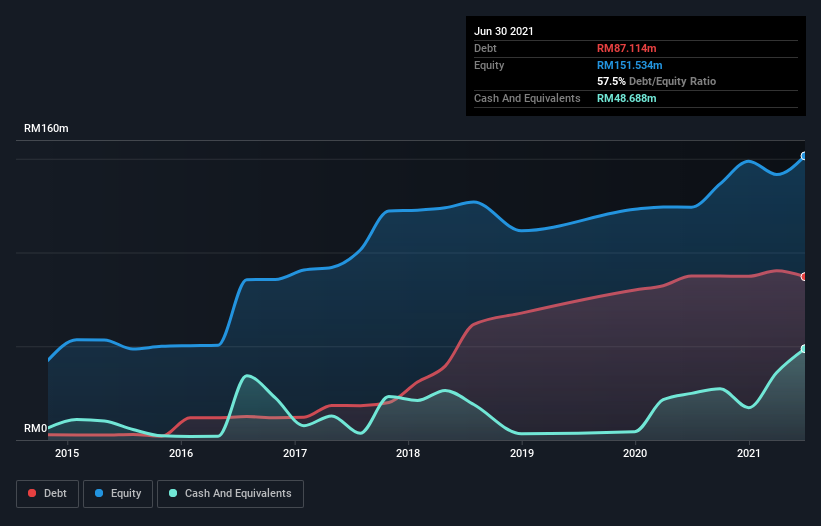Some say volatility, rather than debt, is the best way to think about risk as an investor, but Warren Buffett famously said that 'Volatility is far from synonymous with risk.' When we think about how risky a company is, we always like to look at its use of debt, since debt overload can lead to ruin. As with many other companies OCR Group Berhad (KLSE:OCR) makes use of debt. But the more important question is: how much risk is that debt creating?
When Is Debt A Problem?
Debt assists a business until the business has trouble paying it off, either with new capital or with free cash flow. Part and parcel of capitalism is the process of 'creative destruction' where failed businesses are mercilessly liquidated by their bankers. However, a more frequent (but still costly) occurrence is where a company must issue shares at bargain-basement prices, permanently diluting shareholders, just to shore up its balance sheet. Of course, plenty of companies use debt to fund growth, without any negative consequences. The first step when considering a company's debt levels is to consider its cash and debt together.
Check out our latest analysis for OCR Group Berhad
What Is OCR Group Berhad's Net Debt?
The chart below, which you can click on for greater detail, shows that OCR Group Berhad had RM87.1m in debt in June 2021; about the same as the year before. However, it also had RM48.7m in cash, and so its net debt is RM38.4m.

How Healthy Is OCR Group Berhad's Balance Sheet?
Zooming in on the latest balance sheet data, we can see that OCR Group Berhad had liabilities of RM141.2m due within 12 months and liabilities of RM70.3m due beyond that. Offsetting these obligations, it had cash of RM48.7m as well as receivables valued at RM156.8m due within 12 months. So its liabilities total RM5.97m more than the combination of its cash and short-term receivables.
Since publicly traded OCR Group Berhad shares are worth a total of RM73.7m, it seems unlikely that this level of liabilities would be a major threat. However, we do think it is worth keeping an eye on its balance sheet strength, as it may change over time. The balance sheet is clearly the area to focus on when you are analysing debt. But it is OCR Group Berhad's earnings that will influence how the balance sheet holds up in the future. So when considering debt, it's definitely worth looking at the earnings trend. Click here for an interactive snapshot.
Over 12 months, OCR Group Berhad made a loss at the EBIT level, and saw its revenue drop to RM66m, which is a fall of 7.4%. That's not what we would hope to see.
Caveat Emptor
Importantly, OCR Group Berhad had an earnings before interest and tax (EBIT) loss over the last year. Its EBIT loss was a whopping RM10m. Considering that alongside the liabilities mentioned above does not give us much confidence that company should be using so much debt. Quite frankly we think the balance sheet is far from match-fit, although it could be improved with time. Another cause for caution is that is bled RM3.3m in negative free cash flow over the last twelve months. So suffice it to say we do consider the stock to be risky. When analysing debt levels, the balance sheet is the obvious place to start. But ultimately, every company can contain risks that exist outside of the balance sheet. To that end, you should be aware of the 3 warning signs we've spotted with OCR Group Berhad .
If, after all that, you're more interested in a fast growing company with a rock-solid balance sheet, then check out our list of net cash growth stocks without delay.
New: AI Stock Screener & Alerts
Our new AI Stock Screener scans the market every day to uncover opportunities.
• Dividend Powerhouses (3%+ Yield)
• Undervalued Small Caps with Insider Buying
• High growth Tech and AI Companies
Or build your own from over 50 metrics.
This article by Simply Wall St is general in nature. We provide commentary based on historical data and analyst forecasts only using an unbiased methodology and our articles are not intended to be financial advice. It does not constitute a recommendation to buy or sell any stock, and does not take account of your objectives, or your financial situation. We aim to bring you long-term focused analysis driven by fundamental data. Note that our analysis may not factor in the latest price-sensitive company announcements or qualitative material. Simply Wall St has no position in any stocks mentioned.
Have feedback on this article? Concerned about the content? Get in touch with us directly. Alternatively, email editorial-team (at) simplywallst.com.
About KLSE:OCR
OCR Group Berhad
An investment holding company, engages in the property development, construction, project management consultation, and related businesses in Malaysia.
Slight risk with questionable track record.
Market Insights
Community Narratives



